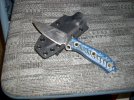I don't know much about bushcraft, but i occasionally see certain higher end brands of knives getting mentioned as tough, or useful for outdoor use.
. . . .
what i don't see much is a mention of chris reeve fixed blades such as shadow III, or another brand, busse.
am i wrong? are they used often and i just missed the posts?
do these actually make good bushcraft knives or it more hype than anything?
. . . .
so, whats your experience with chris reeve and busse? do they deliver?
Don't have experience with Chris Reeve, but I do with Busse.
First, I think the main reason you don't see them much in this forum is because people tend to go for the more "traditional"
styled knives. So a lot of it is just looks.
Now if you look at the cost of Busse (when the knives are offered by Busse, not the secondary market) and Bark River, you'll find that similarly sized knives are fairly close in price.
Performance-wise, some of the prejudice against Busse is due to insisting on using the factory edge, the rest is a dose of closed-mindedness.
The factory edges come toothy which, given the chosen use for most of their knives -- combat type duties -- a toothy edge makes sense. It will cut through webbing and such things very quickly, without necessitating serrations. They are, however, not too great for wood. All it takes to make them good for wood is to run a fine stone over the edge followed by a soft Arkansas stone or stropping to polish the edge.
The closed-mindedness comes in a few forms. First is the idea that Busses are "sharpened prybars". Now, Busse does do some limited runs of knives, such as an Active Duty that was something like .320" thick. But those are produced on more or less a novelty basis. Let's tackle this prejudice first. We'll go with the flagship knife, the CGFBM -- Combat Grade Fusion Battle Mistress.
Let's compare it to the Bark River Aurora -- considered by many (including me) to be the perfect "bushcraft" knife:
Very different knives Obviously prejudiced against the FBM. . .or is it?
OK, the Aurora is a convex grind knife, .150" at the spine. The CGFBM, .250" thick at the spine, and flat ground to a 20 degree secondary bevel.
Ah, but the width of the blades. The Aurora is .990" from edge to the spine, the CGFBM 2" from edge to the LOW spot on the scallop. The Aurora is .150" thick at .990", the FBM is roughly .180" thick at .990" from the edge. Not such a difference, eh? In fact, with a smoothed edge, the FBM slices quite well.
Then look at, say, the Hellrazor and Skinny ASH -- both with ~ 6" blades, .187 thick. The RC6 is nearly the same size, but we keep hearing about how great the RC4 is, right? The RC4 is .187" thick, with a flat grind to a 20 degree secondary bevel. The HR and SASH, are longer, but .187" with a flat grind to a 20 degree secondary bevel. Both the RAT blades and Busses are coated. If the RC4 is a good woodcrafter (and also the RC6), then how are the HR and SASH
not?
As Rotte mentioned I have a BAD (Boney Active Duty), that I think is very good at Bushcraft (Chopper likes it, too):
1/8" thick, flat ground, tapers distally from scales to point. Nearly identical in blade profile to the RAT RC3. Great slicer, and although it's not rated by Busse for prying doors, it drills, pries and cuts up wood with impunity.
I remember when Swamp Rat had just come out. They had their SR101 (Swamp Rat's proprietary steel) versions of the Busse Basic series (BattleRat, Camp Tramp, Bandicoot, Howling Rat). Everyone on the Swamp Rat was going ga-ga over how
great they were in the woods.
So once we get past our "it has to be traditional looking to be good in the woods" prejudice, (a prejudice I was guilty of for a long time) we find Busses are quite fine in the woods.
People may not like the prices, but then that makes me ask why Himalayan Imports blades aren't more popular than they are in WS&S. . .

and families help each other out. i have a becker necker, but my main go-to blades will always be custom from now on. not that there's anything wrong with reeves or busse. it's just my personal preference.





